Why is the water cloudy or yellow in the well: causes of pollution and methods for eliminating them
When constructing a well, we imagine how we will drink tasty, crystal, and cold until our teeth ache well water directly from a galvanized bucket. But reality is sometimes far from fantasy, and we discover that the state of the water is not credible. The result of quenching thirst can be unpredictable and even dangerous. Do you agree?
We will tell you why there is muddy water in the well, and we will explain in detail how to eliminate the causes of this phenomenon. The article presented for consideration describes all types of reasons affecting the purity and chemical composition of water in a private source. Here you will learn not only about methods of cleansing and disinfection, but also about the rules of prevention.
The content of the article:
Causes of cloudy water in a well
As a rule, well owners prefer to drink water from a natural source, even if they are connected to a central water supply.
It is believed that self-produced water is similar to spring water and healthier than water that is chlorinated. But over time, the water we get from the well loses its transparency. What could cause such an unpleasant phenomenon?

Tightness of well rings
When constructing a well reinforced concrete rings, which are components of this structure, are installed on top of each other. The seams between them are sealed.
But, over time, soil movement can lead to partial displacement of the rings relative to each other. At the same time, the tightness of the seams is also broken.
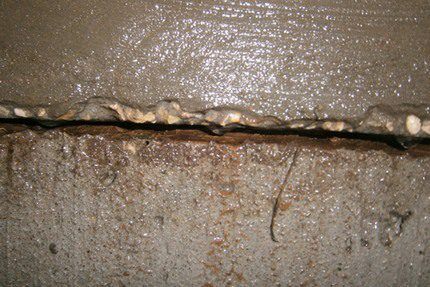
Spring floods, heavy rainfalls and widespread snow melting create excess load on the joints of the rings, as a result of which contaminated water begins to flow into the well. A cloud forms.
Not only do you want to drink such water, but you also don’t want to use it for everyday household needs. Moreover, cloudy water may contain dissolved chemicals that are hazardous to health.
Change in aquifer composition
Sometimes contaminants do not enter the well through the seams between the rings. They can poison the aquifer itself, thanks to which the structure is filled with water. This happens if there is an enterprise near your site that discharges its industrial wastewater into a natural body of water, ruining it and the surrounding area.
In this case, the water may not only become cloudy, but also acquire an unnatural color. The shade of the liquid will depend on what type of pollution has affected it. This type of pollution is the most difficult to deal with: well water treatment will not bring the desired result.
After all, new portions of water from the feeding layer will return the problem that has arisen. We can only rely on a filter system that should be placed along the water path from the source to the place of its final consumption.
Causes of excess iron
If yellow water appears in your well, then the reason for this may be industrial wastewater or high iron content. In the first case, the color of the liquid is usually very pronounced and may be accompanied by a chemical odor. In the second, only the tint of the water will be yellowish.
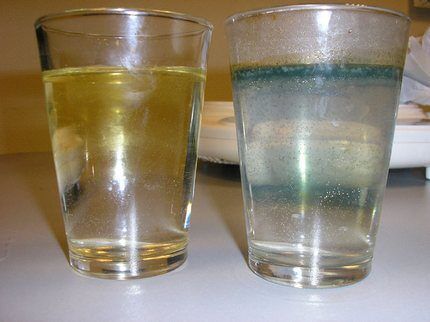
To eliminate high iron content, it is necessary to use special filters that can provide such cleaning.
Water stagnation problem
Another reason for cloudy water in a well can be its stagnation. Perhaps the water source is not used as often as we would like. The water is not renewed and stagnates.
Organic substances penetrating into the well shaft from the outside begin to decompose. This process is accompanied by an unpleasant odor of hydrogen sulfide and a change in the color of the liquid.
Of course, you can’t drink such water, and you wouldn’t want to: it has a specific taste. The smell, color and taste arise due to the development of putrefactive bacteria in the water. This problem is corrected by cleaning the well. Just clean it up and disinfect the water source You will have to do this more than once, but regularly, not forgetting to give this process due attention and time.
Well design defects
When direct sunlight penetrates freely into the mine, ultraviolet radiation creates ideal conditions for the development of bacteria and the proliferation of microorganisms. A greenish tint of water and an unpleasant odor will signal to us that the “process has begun.” In particularly advanced cases, the walls of the structure may become covered with green mosses.

The source must be protected from direct sunlight and debris. You can do this using arrangement of the source, structures over the shaft of a canopy or gable house. You can simply close the shaft with a lid.As a rule, this problem is solved during the process of choosing the shape of the future structure.
Error during pump installation
Sometimes the appearance of the water in the well does not cause concern, and its cloudiness occurs only after the pump is started. It turns out that the equipment is simply installed incorrectly and during operation it picks up silt from the bottom, which causes cloudiness in the water. This happens if vibration pump installed too close to the bottom or works too actively and powerfully.
If the change in the state of the liquid is caused by the operation of the pump, it will have to be dismantled and reinstalled again, having first studied in detail the instructions for using the equipment.
The distance from the suction part of the pump to the bottom surface must be no less than 70-80 cm. If the measures taken do not help, you should use a pump with a different type of liquid suction.
Methods for eliminating cloudy water
If a problem occurs, it is necessary to take measures to eliminate it. You won’t drink and use muddy water with an unpleasant odor and taste for cooking, will you? What can be done?
A set of well cleaning works
The measures taken always depend on the source of the problem. If turbidity is formed as a result of water contamination with pieces of silt and sand, you need to install mechanical filters that will capture this suspension and prevent it from being removed from the water.
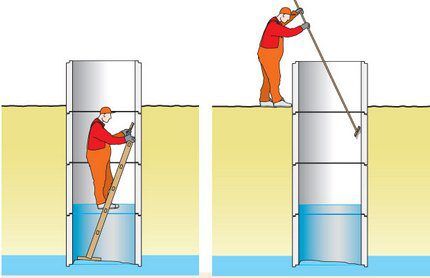
If dirt is brought with it by water that seeps into the gaps between the rings of the shaft, measures must be taken to eliminate the entry holes for it.If turbidity appears after heavy rains, then the cause of the contamination really lies in the insufficient tightness of the seams.
Once the cause of the trouble has been established, work can begin to restore water quality.
To do this you need:
- using a pump, pump out all the water in the well from the well shaft;
- armed with a scraper and a stiff brush, lower yourself on a cable into the shaft to thoroughly clean the inner surface of its rings from deposits of any kind;
- disinfect all concrete surface of the mine;
- Use buckets to scoop out from the bottom of the structure all the silt, deposits and debris that has accumulated there during operation;
- examine the walls of the well: coat the joints of the rings, as well as cracks and chips discovered during the work, thoroughly with sealant;
- create a clay castle if it was not provided for during the construction of the well.
As a preventive measure to prevent water pollution, you can use a bottom filter made of aspen.
What is a clay castle
Turbid water in a well shaft can appear both during its operation and almost immediately after digging. This happens if during the installation of the well a clay castle was not built - a structure that is intended as an artificial barrier to prevent precipitation and melt water from entering the well.
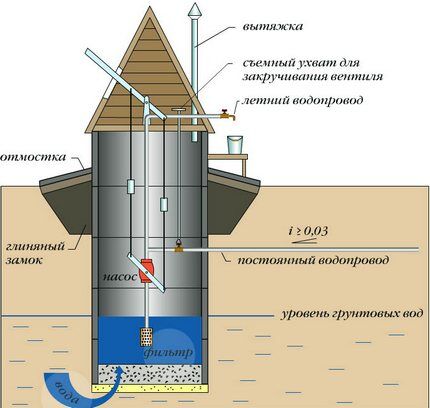
Perhaps the lock was made, but over time it failed or did not meet the technological requirements. In this case, the old clay protection will have to be dismantled and a new, high-quality one installed.
Work on the manufacture of a new clay castle is carried out in the following order:
- Preparation of material. Take fatty clay and add sand to it so that it makes up at least 15% of the mixture. When adding 20% lime to the working mixture, its composition will improve. Make sure that the clay does not dry out while working.
- Digging a trench. Around the top ring of the well it is necessary to dig a trench approximately 2 meters deep and 50 cm wide.
- Castle Formation. The resulting trench must be filled with clay and compacted well. Do not forget to make a slight slope from the ring to the periphery, which will not allow rain and melt water to accumulate around the mine alignment. Crushed stone is poured onto the clay and the castle is concreted, making it as secure as possible.
Such a clay castle will perfectly protect the contents of the well, draining water from the outer walls of the structure.
We disinfect the well
The appearance of bacteria in well water is accompanied by an unpleasant odor. This is exactly what hydrogen sulfide smells like, which occurs during their life processes. You can't drink this kind of water. It is necessary to disinfect the well and get rid of bacteria.
There are two main ways to solve this problem:
- surface treatment with ultraviolet lamps;
- mine cleaning with chlorine.
Which disinfection method is more effective? Let's figure it out.
UV treatment
The disadvantage of disinfection using ultraviolet light is the high level of costs for this procedure. The method also has undeniable advantages: its use does not require significant preparatory work, and the taste of water treated with ultraviolet light does not change after this procedure.

The source of ultraviolet radiation is special devices that must be installed indoors, close to the place of water consumption.
It turns out that ultraviolet radiation will have nothing to do with the well itself, since the location of the radiation source is the consumer’s home. This treatment is used as a preventive measure that can prevent the appearance of bacteria.
It turns out that cleaning with active chlorine is the only way to disinfect a mine. It is produced if it is believed that there are already bacteria in the water. After using chlorine, you can connect the ultraviolet installation.
Step-by-step cleaning with active chlorine
Unlike ultraviolet radiation, active chlorine can adversely affect human health. When using it, you must carefully follow the recommended dosage.
Disinfection work is carried out by specialists equipped with protective equipment: respirators and special gloves. The procedure itself is strictly regulated by SanPiN.
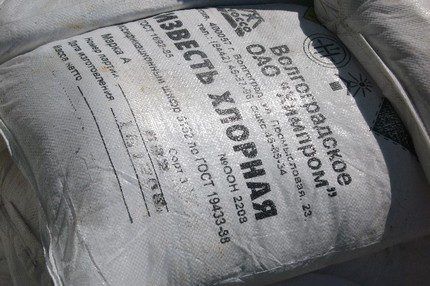
The entire disinfection procedure can be roughly divided into the following stages:
- preliminary work;
- cleaning the well shaft;
- final disinfection.
At the stage of preliminary disinfection, it is very important for us to calculate as accurately as possible exactly what volume of water is in the well at the moment.Knowing the parameters of the rings that form the walls of the structure and the water level in it, calculating the volume is not at all difficult.
Now we need to calculate the total weight of active chlorine that we will pour into the mine, based on the fact that for every liter of water we will need 10 grams. powder.
Add the substance and shake the resulting solution. To do this, scoop up the liquid with a bucket and immediately pour it back. We repeat this maneuver several times, after which we close the shaft with a lid, allowing the chlorine to do its work over the next 2 hours.
After two hours, you can begin cleaning the mine. To do this, it is necessary to completely free it from water. Now the mine needs to be thoroughly cleaned, removing moss and mucus from the walls, and silty deposits and all kinds of debris from the day. All dirt must be raised to the surface and disposed of by burying it away from the well.
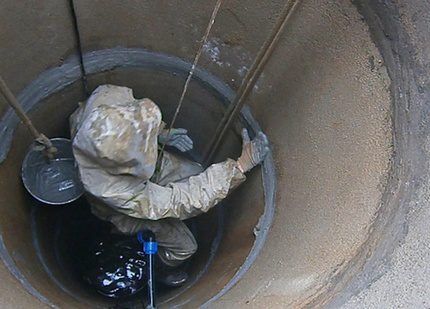
We assess the condition of the walls: reveals cracks and leaky seams. We eliminate identified defects by performing local repair work. Now the inner surface of the shaft should be disinfected. Prepare a solution at the rate of 3 g. active chlorine or 15 g. bleach per 1 liter of water and apply it to the surface using a hydraulic sprayer, roller or brush.
After completing this work, you can close the well and wait until the column is completely filled with water.
The third and final stage of treatment is repeated disinfection. We will need a chlorine solution again. To prepare it, you need to dissolve 200 grams in 1 liter of water. bleach.
The solution should be left to sit for an hour.We separate the resulting composition: we don’t need the upper part before the sediment, but pour the lower part into the well.
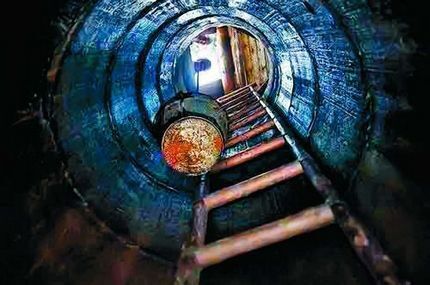
We mix the water in the well with a bucket, as we did earlier, and leave it for a day. A day later you need to do the same procedure again. Another day has passed, now you need to completely pump out all the water and wipe the walls of the shaft with brushes, a mop or any other similar device. Then the walls are rinsed with clean water.
Now we will have to fill the column with water several times and completely pump it out. This process will be completed only when the water stops smelling like chlorine and there is no foreign taste in it. Let's exercise reasonable caution: over the next two weeks we will drink only boiled water.
The quality of water is not always determined by taste and smell. It's better to confirm its characteristics laboratory analysis. How to take a sample and where to submit it for research is described in detail in our proposed article.

Conclusions and useful video on the topic
If the water disinfection procedure seems too complicated to you, you can turn to professionals for whom this work is familiar and understandable. Watch the video to see exactly how they get down to business:
This video presents different types of work aimed at a single result - to make the water we get from the well tasty and safe for our health.Of course, the video is frankly promotional in nature, but the general work process is presented clearly, accessiblely and in sufficient detail.
Cloudiness of the water in the well is a signal that appears if the prevention of contamination of your well has failed. There are many reasons for this, and we have described them in detail in this article so that you can easily find the source of your own troubles.
Most of the troubles could be avoided if you read the instructions for the pump more carefully, provide a cover and canopy that protect the shaft from the sun and dirt, initially correctly position the well on a hill, do not forget about the clay apron around its perimeter, and so on.
However, the situation is not fatal, and you can still fix it by following our advice or turning to professionals who will certainly help you.
Want to share your own methods and tricks for restoring well water quality? Please write comments in the block below. Here you can ask a question and post unique photos of the cleaning process.




I have been trying to solve the problem of cloudy water in the well for two months now. I immediately rejected some options: everything is fine with the rings, I’m sure of that, and there is no defect in the design either. I thought maybe there was a lot of iron, but a special filter also did not help solve the problem. I’m thinking of making a clay castle, but I need help, if someone has made it, tell me how and where to start? What are the nuances? I will be glad for any information.
Yes, in general there is nothing complicated here. The most important task is to make the most reliable drainage of water from the concrete rings of the well.You just dig a deep trench around the perimeter - about 2 meters, there is no point in digging more (water definitely won’t seep through such a thickness), up to half a meter wide (the wider, the better). Then you fill it all with a clay mixture with sand and tamp it well (it’s best to walk with a tamper). Then you make a small angle from the same clay (like a slope from the rings of a well to the ground). And you strengthen this thing with small crushed stone and a layer of concrete. Water will roll down the concrete and will not accumulate near the rings. You also make a convenient approach to the well itself to collect water. That's what science is all about. But it’s better to take a water analysis, otherwise you may have another problem.
Hello. The water purification device is selected according to its purpose. This is the most effective method. It is not advisable to think that the water is cloudy due to iron and buy such a filter right away. It is best to have the water analyzed and find out its chemical composition, and only then choose treatment equipment. I would also like to know if the water was like this initially or did you just dig a well? Does the water have a tint?
I also had problems with cloudy water. At first I put it on the back burner, but over time the water quality deteriorated even more. I realized that I needed to urgently decide, since the main source of water for me is the well. At first I relied on poor sealing of the rings, I checked everything fine. Then I randomly installed filters to purify the water from large amounts of iron and the problem was solved. Now I’m reading all the factors that could have influenced me and I understand that I was very lucky that my problem was solved quite easily.
Everything about the causes of water pollution has been clearly described, but I want to argue about cleaning, since it is better not to do this yourself. If the water has changed color, you should immediately do a professional examination; it is also recommended to do it at the very beginning of using a well or borehole. No matter how good a cleaning method you have, there are some elements that cannot be eliminated at home.
Laboratory chemical and bacteriological analysis of water from a well, which you call an examination, of course, will not be superfluous. But the cleaning methods listed in the material are sufficient for most situations. Unless some plant starts releasing emissions into groundwater.
The well is 35 years old. Always after the spring pumping of water, it settled and became transparent.
This year I decided to clean the well and found specialists. We repaired the seams, crossed stainless steel dog rings, put a stainless steel mesh over 2 seams, cleaned the walls of the well with brushes, made a filter from aspen with crushed stone, and disinfected it with potassium permanganate.
They turned off the water several times, a week later we arrived at the dacha, and the water was cloudy and there was a greasy film on top, they turned off the water again, the water was still cloudy. Now I regret that I started this procedure.
Why doesn't the water become clear?
We pumped out the water 5 times after repairing and cleaning the well, but the water is still cloudy and whitish in color. Why?
Good afternoon. It all depends on how the well was pumped out. If it was a salvo, that is, intense - a large volume in a short period of time - then after it the water inside will always be cloudy. Causes:
• After such pumping, water enters the well with high pressure, dragging the soil with it. Hence the dregs.
• Under the pressure of water, the seals between the outer planes of the rings and the ground are damaged. This entails an increase in the gap through which water from the high water begins to flow into the well. And she's always muddy.
Salvo pumping is needed for newly opened wells. Old buildings must be handled carefully.
Can a crushed aspen filter cause turbidity in the water?
Good afternoon. Wood does not deteriorate in water, but it quickly rots in air. Therefore it is quite possible.
After draining the water, the new well collects clean, clear water, but after a day it begins to become cloudy and yellow, getting worse every day. First, you take out a bucket of water, it is transparent, and after 15-17 hours you cannot see the bottom of the bucket (yellow, muddy water). The rings do not leak, the filter at the bottom of the well is perfect. What happens to water and what to do?
The water becomes cloudy only in summer, in other periods it is clear without any precipitation. In the summer, the smell of hydrogen sulfide periodically appears, not only in me but throughout the area as a whole. What to do in such cases?